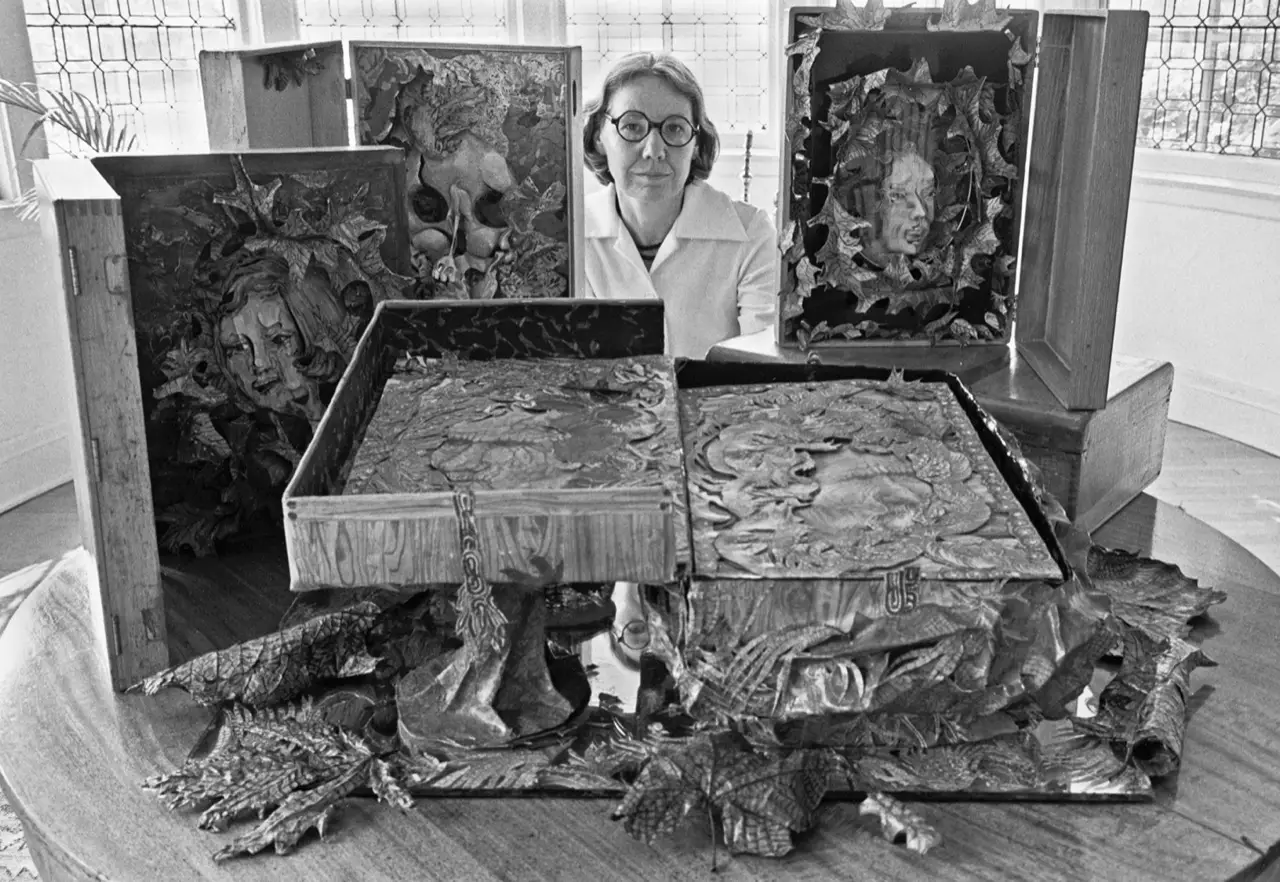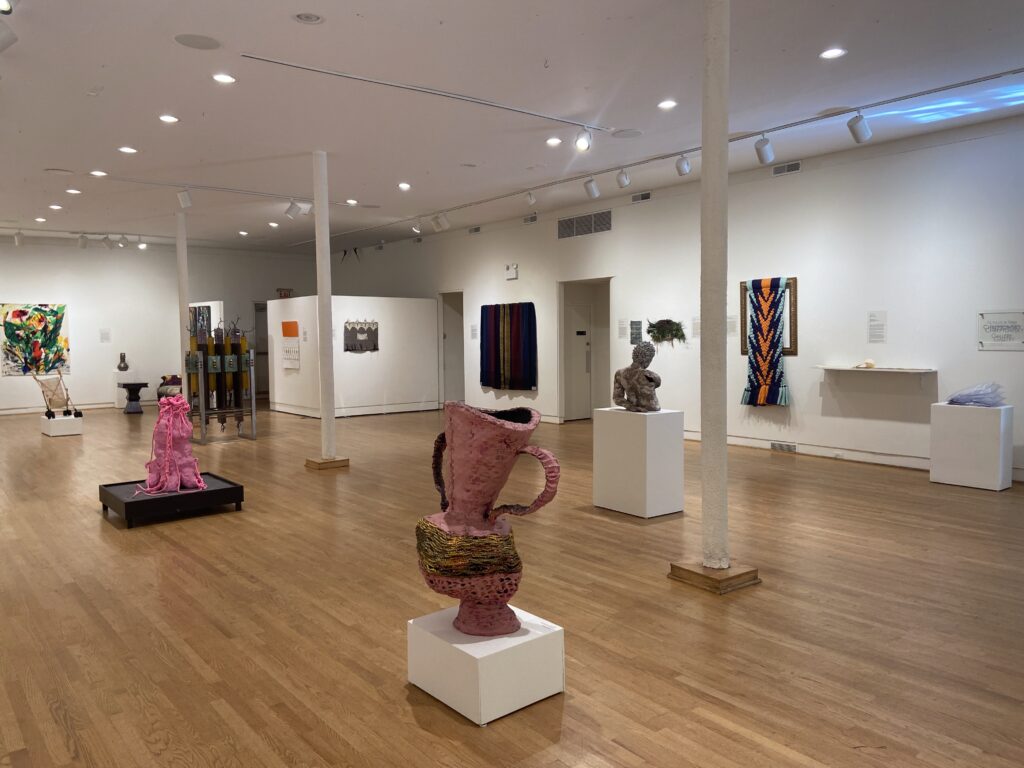On a dark, overcast, rainy day in the middle of May, a few friends and I headed over to Chicago’s Hyde Park Art Center nestled on a quiet block of Cornell Avenue at 51st Street. We had heard that the works of a particular local, community-based artist were being exhibited for the first time since we moved to the neighborhood for school a few years before. Hailing from a tight-knit community of students, scholars, artists, and aspiring curators stemming from UChicago’s brown and Muslim circles, we have made an intentional effort to contextualize our creative and communal initiatives within the broader Hyde Park community. At one point while helping fellow students organize a local artist-led workshop, and at another while helping set up for our annual Islamic art exhibit at a local chapel, I realized how distanced the student community can be from an entire history and tradition of local artistry in Hyde Park. As I headed over to visit the Hyde Park Art Center’s exhibition, Alice Shaddle: Fuller Circles for the first time, my motivations and curiosities stemmed mainly from wanting to see what the 50+ year work and legacy of this local community-based artist looked like. I walked in with the eye and intention of a community builder and aspiring curator; I walked out an hour and a half later with the heavy heart and mind of a person navigating the complexities of the tangled mess of womanhood and struggling with an everlasting nostalgia for childhood memories at the family dining table.
The exhibition Alice Shaddle: Fuller Circles at the Hyde Park Art Center is a reintroduction of the diverse work of Alice Shaddle (1928 – 2017) to new audiences through a poignant exploration of the artist’s intricate weave of family, community, and curation. Shaddle’s art is a vibrant tapestry where personal history and community engagement intersect, revealing the profound influence of her familial and communal connections on her creative practice. Fuller Circles is a celebration of Alice Shaddle’s remarkable ability to transform the personal into the universal. It also demonstrates the transformative potential of an artist who can craft complex narratives and personal history into her work. Her art, enriched by the contexts of family, home, and community, serves as a powerful reminder of how deeply interconnected our creative and personal lives can be. In revisiting Shaddle’s work through this exhibit, we are invited to reflect on the circles of influence that shape all of our lives, and the ways in which our environments, relationships, and histories are inextricably linked in the fabric of our creative expressions.
Family as Collaborators
Fuller Circles is deeply enriched by the involvement of Shaddle’s family, particularly her son Charles Baum and grandson Cain Baum, who played crucial roles in the research and curation of the exhibition. This familial collaboration echoes the very nature of Shaddle’s work, which often blurs the lines between personal artifacts and public artworks. Her pieces, such as the postcards created for friends and family, embody this intersection, transforming everyday exchanges into enduring artistic expressions.
As noted in the Hyde Park Art Center’s online announcement, the exhibition is informed by a three-year research project that dives into Shaddle’s and her ex-husband Don Baum’s lives and works. This project, conducted by their descendants, highlights how family narratives and artistic legacies intertwine, creating a dynamic continuum of artistic influence and heritage.
The Home as Muse
Shaddle’s long-term residence in Frank Lloyd Wright’s George Blossom House in Hyde Park provided more than just shelter; it was a constant muse. The architectural features of the house, with its early Prairie School design, permeate her work and are manifest in her meticulous layering techniques and the incorporation of natural light and organic forms. This home was a living space that evolved with her art, where the boundaries between private life and public artistic expression blurred. The house itself, preserved and honored through Shaddle’s stewardship, becomes a silent collaborator in her art, grounding her abstract explorations in a tangible sense of place and history.
Curation as Narrative
Curators Nicholas Lowe and Lisa Stone have woven a rich narrative that highlights Shaddle’s complex legacy. Their approach to curation goes beyond displaying artworks; it tells a story of an artist deeply embedded in her community and family, and how these relationships influenced her artistic journey. The exhibition design, which echoes the architectural nuances of Shaddle’s home, further immerses visitors in the environment that so profoundly shaped her work.
With Lowe and Stone’s thoughtful curation, every piece of artwork serves as a chapter in Shaddle’s artistic journey. By eschewing traditional labels and descriptive plaques, they compel visitors to engage directly with the art, allowing for a more intimate and authentic experience. This deliberate choice not only emphasizes the tactile and emotional aspects of Shaddle’s work but also encourages viewers to interpret and connect with the pieces on a personal.
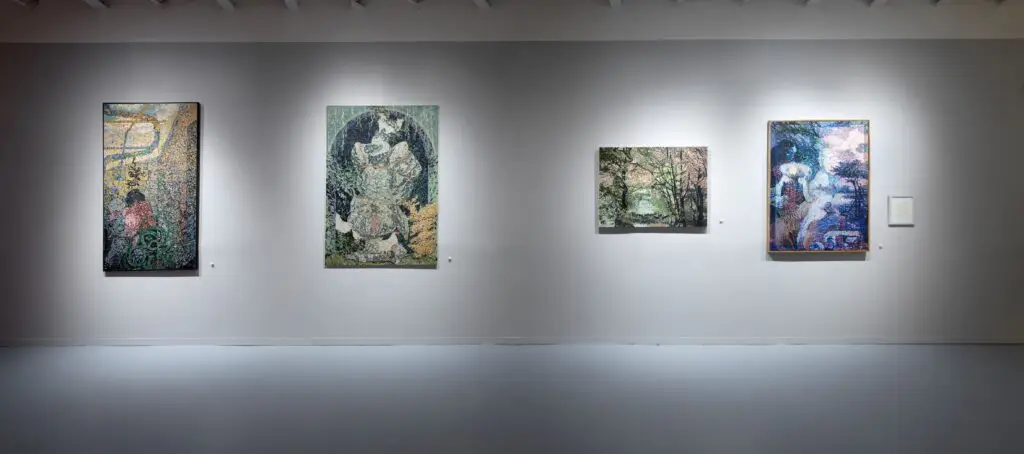
One of the most compelling aspects of the exhibition is its thematic cohesion, where individual works are curated to interrelate and resonate with one another. By selecting pieces from distinct periods of Shaddle’s career, Lowe and Stone highlight the evolution of her artistic language while elucidating recurring motifs and themes. The inclusion of Shaddle’s layered, textured creations, such as the hauntingly detailed “Birthday Cake” (1964) and her large-scale collages, invites viewers to look beyond the surface. As critic Noah Berlatsky writes for Observer, these works are not just visual experiences but also tactile and emotional journeys that reflect Shaddle’s life stages and her interaction with the world around her. Whether it’s the daring papier-mâché bas-relief sculptures, the haunting shadow boxes, or the meticulously crafted collages, each artwork serves as a testament to Shaddle’s boundless creativity and unwavering commitment to her craft. Through careful juxtaposition and arrangement, the curators not only showcase the breadth of Shaddle’s oeuvre but also invite viewers to discern the underlying narratives that unite her diverse body of work.
Central to the exhibition narrative is Shaddle’s deep-rooted connection to her family and community. By incorporating personal anecdotes and archival materials, the curators offer glimpses into Shaddle’s intimate relationships and the profound impact they had on her artistic practice. From her collaborative endeavors with Don Baum to her daily correspondence with close friend, colleague, and fellow artist, Kathryn Kucera, Shaddle’s artistry was intricately intertwined with the people and places she held dear. Through this lens of familial and communal bonds, the exhibition transcends mere retrospective homage, becoming a celebration of Shaddle’s life and legacy within the context of her supportive network.
In essence, Fuller Circles transcends the traditional confines of a curated exhibition, evolving into a narrative odyssey that navigates through the complexities of Alice Shaddle’s artistic universe. As visitors traverse through the exhibition space, they become active participants in Shaddle’s story, bearing witness to the enduring resonance of her legacy and the timeless beauty of her “fuller circles.” I personally experienced the full effect of such a curatorial and artistic vision on the windy, rainy day when I first visited the exhibition. I was struck by two pieces in particular – these pieces drew me in and kept my feet rooted as my mind contemplated feelings and memories that I thought I had long ago come to peace with. “Grandmothers and Granddaughters” and “Dining Table” each encapsulate Shaddle’s thematic focus on family, community, domestic space, and memory.
Transcending Connections
“Grandmothers and Granddaughters” is a poignant exploration of generational connections. This piece, displayed in a vitrine, consists of layered paper sculptures that intertwine to depict the dynamic interplay between different generations of women. Shaddle’s use of paper, a medium both delicate and enduring, symbolizes the fragile yet resilient bonds that tie families together. The meticulous layering and intricate details reflect the complexity of these relationships, suggesting a rich tapestry of shared experiences and memories.

This piece not only honors the women in her own life but also speaks to the broader experience of familial legacy and the transfer of wisdom and tradition from one generation to the next, an idea further elucidated in the Chicago visual arts calendar, the Visualist. This piece struck a chord within me, echoing the sentiments of a granddaughter navigating the intertwined paths of womanhood, family heritage and life-building. Having lost my grandmother several years ago to a long term battle with chronic illness that I saw up close and personally, and having grown up with her as a constant source of love, lessons, and memories, I can firmly say that my embodiment as a South Asian Muslim woman contending with multilayered facets of identity and heritage in 21st century America is a direct consequence of her relationship with me. This aspect of Shaddle’s work invites viewers to consider their own familial narratives, prompting a deep, personal engagement with the art. The connection between the artist’s personal history and the viewer’s introspection is a testament to Shaddle’s ability to create art that is both intimate and universally resonant.
Nostalgia and the Domestic Space
“Dining Table” is another profound work that brings Shaddle’s home life into her art and captures the significance of domestic spaces. Featuring Shaddle’s circular wooden table from the Frank Lloyd Wright-designed George Blossom House, the installation blurs the boundaries between art and everyday life. The table, adorned with collages and postcards, transforms a familiar domestic object into a canvas for artistic expression. This piece evokes a deep sense of nostalgia, reminiscent of childhood memories and familial gatherings around the dining table.
Art historian Judith Russi Kirshner’s account of Alice Shaddle’s note cards in the exhibition catalog provides a rich, intimate look into Shaddle’s private artistic practice. For over a decade, Shaddle created more than a thousand collages on five by six-inch notecards, sending them to friends and family. These cards were not merely small-scale artworks but deeply personal communications, featuring photos of recipients, personal and holiday greetings, garden updates, and poems.
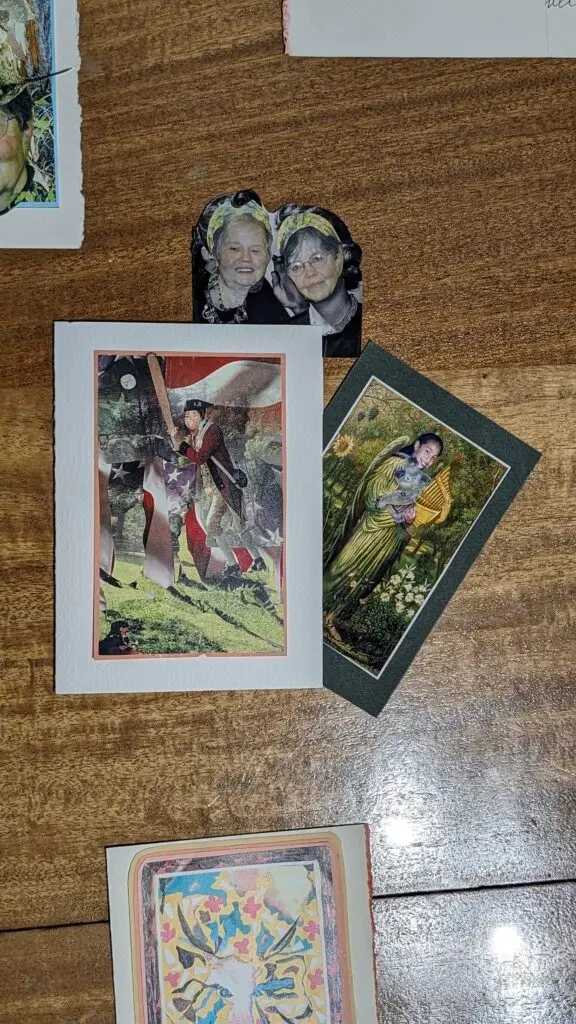
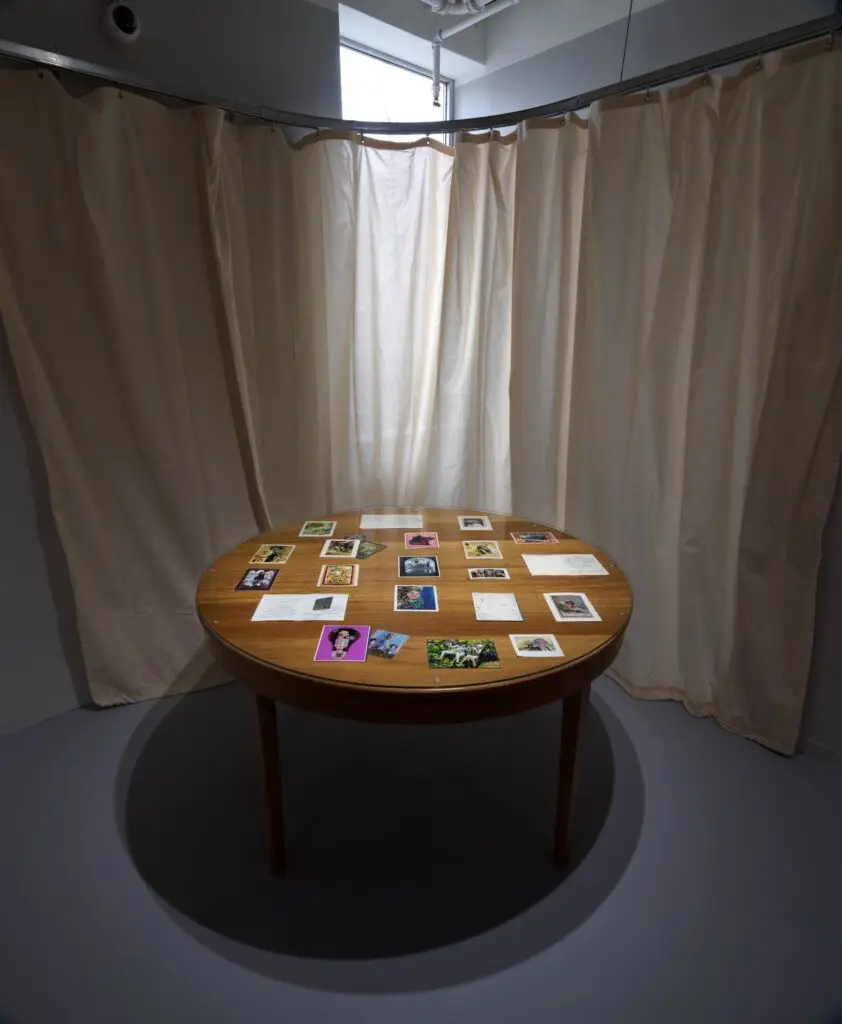
Shaddle’s note cards reveal an affectionate, smart, and playful side of the artist, showing a different facet of her creative spirit compared to her public works. These cards frequently feature photographic portraits of her lifelong artist friend Kathryn Kucera, reflecting Shaddle’s preoccupation with faces and her ability to place them in fantastical, often humorous situations. Kucera’s face might appear surrounded by flowers, playing a guitar, or even adorned with a whimsical hat made of an upside-down hummingbird. These playful and intimate compositions underscore Shaddle’s deep bond with Kucera, highlighting how art served as a medium for maintaining and expressing their friendship.
In my personal viewing, the “Dining Table” installation reminded me of countless evenings in my own home spent gathered around the dining table as my family talked, laughed, and had a cup of tea. It is most viscerally reminiscent of the nights when my mother and sisters would pull the old family albums out of the closet and we would go through our childhood snapshots and spend the night walking down memory lane. Shaddle’s ability to infuse everyday objects with profound meaning elevates the mundane into the realm of the extraordinary, inviting viewers to reconsider the significance of their own domestic spaces. This transformative approach to art reflects the intertwined nature of private and public life, a theme that permeates Shaddle’s work and resonates deeply with those who engage with it.
Fuller Circles is a powerful exhibition that captures the essence of Alice Shaddle’s legacy as an artist deeply embedded in her family, community, and domestic life. Her work, rich with layers of meaning and personal history, invites viewers to explore their own connections and the spaces they inhabit. As I reflect on my visit, I am reminded of the profound impact that art can have by bridging personal and communal narratives, creating a tapestry of shared experiences and memories. Alice Shaddle’s work continues to inspire and provoke thought, offering a timeless exploration of the themes that define our lives.
Community and Artistic Influence: Community as Canvas
Shaddle’s influence extends beyond her immediate family to the broader art community. Her work within the Chicago art community is legendary, if until recently obscured. As a founding member of Artemisia Gallery, she provided a platform for female artists at a time when their opportunities were severely limited. Her dedication to teaching at the Hyde Park Art Center for over five decades further underscores her commitment to nurturing community through art. She not only created art but also fostered environments where others could explore their creativity.
The exhibition Fuller Circles beautifully encapsulates this aspect of her legacy. The inclusion of public programming and curator-led tours ensures that Shaddle’s work continues to inspire and educate new generations, fostering a sense of communal engagement with her art. This community-centric approach mirrors my own intentions as a community builder and curator, underscoring the importance of creating spaces where art and community can intersect and thrive. Perhaps the most impactful testament of Alice’s art and the space she cultivated is that I, a passing visitor, a virtual stranger, after having engaged with her art, can imagine myself enjoying a conversation over a cup of tea with this woman who was so profoundly connected to her community, family, and work. Through her art, she has left behind a legacy that transcends time and space, inviting strangers like myself to become part of the ongoing conversation that she so intentionally cultivated.
Installation photos by Tom van Eynde.
Alice Shaddle: Fuller Circles is on view through June 16, 2024 at Hyde Park Art Center.
ABOUT THE AUTHOR

Fariha Koshul
Fariha Koshul, a Chicago-based writer for Terra Foundation for American Art, combines her academic training in ethics, anthropology and sociology with practical experience in digital curation, collections management and archiving. Her time at the University of Chicago involved leading research projects and collections care aimed at incorporating ethical practices in diverse cultural contexts. Fariha’s work is marked by a deep commitment to an understanding of the ethical implications of working with anthropological material, specifically in curatorial and museum spaces, and to the promotion and preservation of cultural, artistic and faith-based narratives and communal and social histories.


